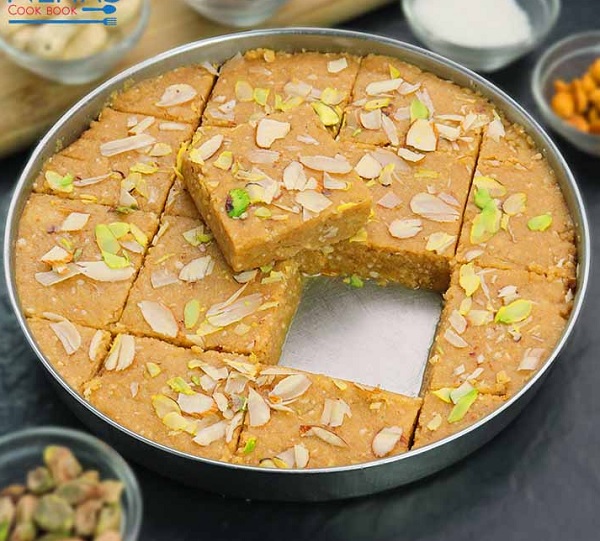Sukhadi is a traditional Gujarati sweet made from wheat flour, ghee, and jaggery. It’s simple to prepare and known for its rich, melt-in-the-mouth texture.
Sukhadi, hailing from the vibrant state of Gujarat, is a treasured confection deeply rooted in its culture. This delightful sweet, often made during festivals and special occasions, has garnered affection from those who savor traditional Indian desserts. Its appeal lies in the unassuming list of ingredients that magically transform into a decadent treat.
With just a handful of pantry staples, anyone can recreate the warmth and nostalgia of a Gujarati household. The beauty of Sukhadi lies in its simplicity, making it accessible for home chefs of all skills levels. Whether it’s a festive celebration or a quiet moment with loved ones, the comfort of homemade Sukhadi promises to be an unforgettable experience.
The Origins Of Sukhadi
Sukhadi, known for its sweet taste, hails from Gujarat, a western state of India. This dish forms a core part of Gujarati cuisine. People make it using simple ingredients. These include wheat flour, ghee, and jaggery. This simplicity has a deep cultural meaning.
During Gujarati festivals, Sukhadi plays a significant role. It symbolizes joy and prosperity. Families share Sukhadi to celebrate together. Its sweetness is said to bring happiness. Various festivals highlight its importance. These are Diwali, New Year, and family gatherings. Thus, Sukhadi is more than just a treat. It’s a part of tradition.
Essential Ingredients And Substitutes
The traditional Sukhadi, a classic dessert, requires three key components: ghee, jaggery, and whole wheat flour. Each ingredient is vital to create that authentic taste and texture.
For those with dietary restrictions, substitutes are available. Vegan individuals can use plant-based ghee or coconut oil instead of regular ghee. To replace jaggery in this recipe, try using maple syrup or coconut sugar. These alternatives will help maintain the dessert’s rich flavor.
Gluten-free needs are met with buckwheat or almond flour. These flours are friendly to sensitive diets and keep the Sukhadi yummy. Even with these changes, the treat stays true to its roots. Get ready to enjoy every bite!
Mastering The Technique
The Art of Roasting Flour is a key step in making Sukhadi. Begin by heating the pan on a low flame. Gradually add ghee and wait until it’s warm. Next, slowly sprinkle in the whole wheat flour. Stir continuously to avoid lumps. The flour should turn golden brown and aromatic. This indicates it is well-roasted. Be patient; perfect roasting ensures rich flavor and perfect texture.
Melting Jaggery to Perfection is crucial for an authentic Sukhadi. Use a separate pan to melt the jaggery with a little water. The flame should remain low to prevent burning. The texture should be smooth and lump-free. Once melted, the jaggery must cool slightly before combining it with the roasted flour. The right consistency will give Sukhadi its signature sweetness and chewiness.

Texture And Consistency Secrets
The perfect Sukhadi is rich and crumbly. Key is precise measurements and cooking time. Measure ghee and jaggery carefully. Mix them well for a smooth texture. Do not rush the cooking process. Consistent heat ensures ideal hardness. Stir continuously for an even mixture.
Overcooking or undercooking can ruin Sukhadi. It makes the mixture either too hard or too soft. Keep a close eye on color change. It hints proper texture. Check consistency before setting it to cool.
Flavor Enhancements And Personal Touches
Traditional Sukhadi gains new excitement with nuts and spices. Almonds, pistachios, and walnuts add rich texture. They bring nutty flavors to each bite. Cardamom, cinnamon, and nutmeg sprinkle magic into the mix.
These additions transform the recipe. A classic dessert becomes unique to your kitchen. You create a treat that pleases all senses. Think outside the box with ingredients. Try roasted seeds for a crunchy twist. Or add rose petals for a fragrant surprise. The options are endless.
| Nuts | Spices | Unique Additions |
|---|---|---|
| Almonds | Cardamom | Roasted seeds |
| Pistachios | Cinnamon | Rose petals |
| Walnuts | Nutmeg | Choco-chips |

Frequently Asked Questions On Sukhadi Recipe
What Is Sukhadi And Its Origin?
Sukhadi, also known as Gur Papdi, is a traditional Gujarati sweet. It’s a simple dessert made from wheat flour, ghee, and jaggery. Originating in the Indian state of Gujarat, it’s known for its delightful taste and ease of preparation.
How To Make Sukhadi At Home?
To make Sukhadi at home, roast wheat flour in ghee until golden. Add jaggery, mix until it melts. Pour the mixture into a greased plate, allow it to set, and then cut into squares.
Are There Any Health Benefits Of Sukhadi?
Yes, Sukhadi offers health benefits. It’s made with wholesome ingredients like ghee for healthy fats, jaggery for iron, and wheat flour for fiber. It is energy-boosting but should be consumed in moderation.
Can Sukhadi Be Made Vegan?
Indeed, Sukhadi can be veganized. Replace the ghee with coconut oil or any vegan butter. Use vegan jaggery or unrefined sugar to maintain the traditional flavor and texture.
Conclusion
Delving into the realm of traditional Gujarati cuisine with the sukhadi recipe reveals a delightful journey for your taste buds. This sweet treasure, easy to make and rich in flavors, promises to be a hit for any occasion. Embrace the simplicity of sukhadi and let every bite take you closer to the heart of Gujarat’s culinary heritage.
Share it with loved ones or relish it solo; sukhadi is pure comfort in every morsel!

